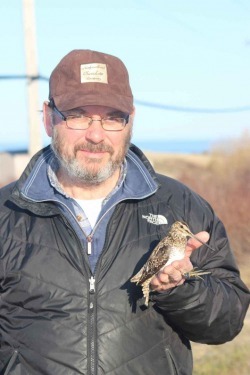Biology professor co-authors paper about bird and dinosaur vocalization

Imagine a 10-ton dinosaur cooing like a dove.
Such a low-pitched sound could have travelled for long distances, like the hoots of large owls or calls of howler monkeys.
While not the typical Hollywood sound effect, new research co-authored by a Memorial University professor shows that dinosaurs could likely coo–in a manner similar to how male pigeons, doves, and even ostriches produce sounds.
The findings were published on July 12 in the online edition of Evolution. Dr. Edward H. (Ted) Miller was co-author on the study with colleagues from Midwestern University, the University of Texas and the University of Utah.
The researchers found that, in addition to the typical bird sounds made with an open beak, vocalizations in many bird species also are produced with a closed beak, while some sort of air sac in the throat is inflated simultaneously. The air sac modifies the vocalization, such that low-pitched calls like coos are emitted.
In some species the air sac is an evolutionarily new structure; in others it is an existing structure co-opted for use in vocal display (e.g. the oesophagus of pigeons). Their work showed that this ability to make cooing, hooting or booming sounds with a closed mouth evolved independently at least 16 times in unrelated bird species.
“Birds are dinosaurs, and their shared family tree is fairly well defined,” explained Dr. Miller. “When we have such a tree, and can see how different species are related, we can determine how often traits like closed-beak vocalization evolved and how old they are, and can make inferences about the evolution of similar traits in unrelated extinct species like dinosaurs.”
Dr. Miller says this study led the research team to multiple individual conclusions that can be lined up to create a coherent view of why and how the structures that enabled closed-mouth vocalization evolved.
“We know that closed-beak vocalizations produced with the aid of air sacs in birds evolved independently in multiple species,” he said. “We know they evolved almost solely in mid-sized to large birds. We know that almost all are used in displays used in what we can loosely call ‘sexual’ circumstances, e.g., in attracting mates. When we look at those facts together with the dated family tree, we can conclude that some dinosaurs must have possessed similar sounds and mechanisms for sound production for use in sexual display.”
Behaviour is increasingly recognized as driving the evolution of biological ornaments, such as tail feathers of the male peacock, or weapons, like teeth and horns.
“In most cases, such structures evolved through direct or indirect sexual competition,” Dr. Miller said. “Such competition often leads to highly skewed mating success, which in turn leads to rapid and divergent evolution of fascinating and bizarre traits like closed-mouth vocalization in birds.”